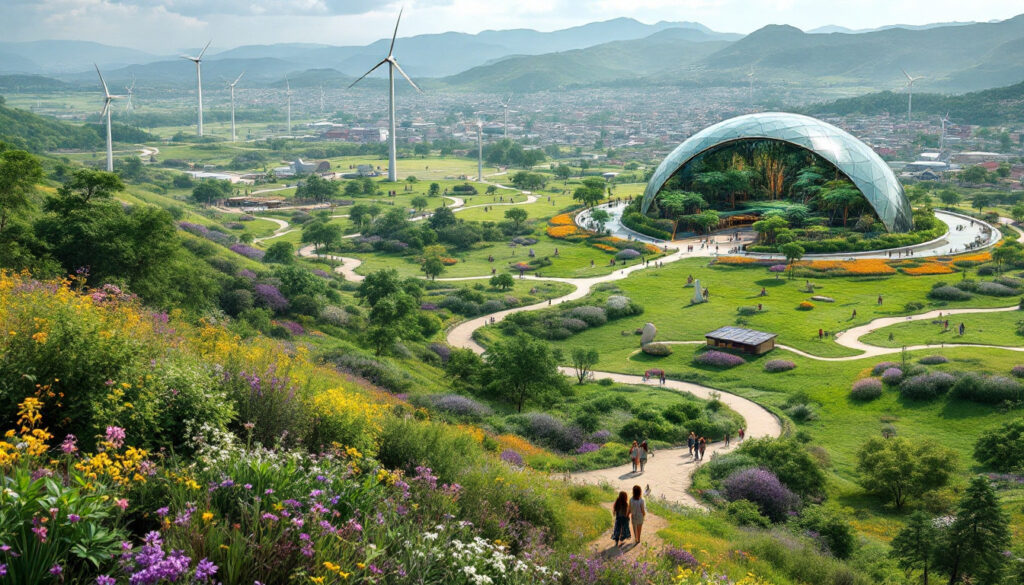What Is Mine Reclamation and Why Is It Important?
Mine reclamation represents a transformative approach to former mining sites, converting them from industrial landscapes into environmentally sustainable, socially valuable spaces. According to Dr. Peter Whitbread-Abrutat, founder of Future Terrains International, proper reclamation creates "long-term environmental, social, socio-economic, and cultural values" that continue to benefit communities long after mining operations cease.
Mine reclamation extends far beyond basic environmental restoration. It encompasses rebuilding community connections, preserving cultural heritage, and creating new economic opportunities for regions often dependent on extractive industries. The mining industry has evolved significantly, shifting from merely making sites "safe and non-polluting" to generating ongoing value that serves multiple stakeholders.
According to International Council on Mining and Metals (ICMM) best practices, effective reclamation planning should begin during the exploration phase, long before the first material is extracted. This forward-thinking approach allows for progressive rehabilitation throughout the mine's operational life, reducing overall closure costs and environmental impacts.
Industry experts note that reclamation bonds (financial assurances set aside for closure) often underestimate actual reclamation costs by 30-50%, highlighting the importance of realistic financial planning for post-mining landscapes.
How Has Mine Reclamation Evolved Over the Past Decade?
Since the publication of the first "101 Things to Do with a Hole in the Ground" in 2009, there has been remarkable evolution in reclamation approaches. Dr. Whitbread-Abrutat describes an "explosion of innovation" in creative reuse of former mine sites, with projects becoming increasingly ambitious in scope and impact.
Europe has emerged as a global leader in mine site reinvention, with Germany's transformation of former lignite mines into the Lusatian Lake District (Europe's largest artificial lake system) and Wales' conversion of former coal landscapes into renewable energy hubs demonstrating the potential for comprehensive transformation. Australia, Southern Africa, and Appalachia have similarly seen substantial improvements in reclamation practices.
Climate change adaptation has become mainstream in reclamation planning, with renewable energy installations including wind turbines and solar panels becoming common features on reclaimed sites. This transition from extractive to sustainable energy production represents a powerful symbolic and practical shift in mining's crucial role in the clean energy transition.
The second book "102 Things to Do with a Hole in the Ground" (2023) features 111 case studies from around the world, demonstrating the global nature of reclamation innovation. These projects range from small community-led initiatives to multi-billion dollar redevelopments.
A lesser-known trend is the integration of Indigenous knowledge into reclamation practices, particularly in Canada and Australia, where traditional ecological knowledge is increasingly valued in restoration design and implementation.
What Are Some Creative Examples of Mine Reclamation Projects?
The Eden Project (Cornwall, UK)
Built in a 160-year-old china clay quarry that many experts deemed impossible to reclaim, the Eden Project has become an international symbol of successful mine transformation. The site features two of the world's largest greenhouses (200m long, 100m wide, 50m high), which house a full-size tropical rainforest and Mediterranean biome.
The Eden Project attracts approximately 1 million visitors annually, generating over £2 billion for the regional economy since opening in 2001. Beyond its tourism impact, Eden has pioneered innovative approaches to reclamation, including specialized soil creation techniques for barren post-mining landscapes.
What's particularly remarkable about Eden is how it transformed Cornwall's perception of its mining heritage from something to be ashamed of into a source of pride and renewal.
True Town Seep Remediation (Ohio, USA)
This innovative project began when Professor John Sabraw (art) and Professor John Reutter (engineering) identified the potential to transform an environmental liability—acid mine drainage from abandoned coal mines—into a creative opportunity. The team collected ochre (iron oxide) from acid mine drainage to create high-quality art pigments, demonstrating a cross-disciplinary approach to reclamation.
The project partnered with Gamblin Artists Colors to produce "Reclaimed Earth" oil pigments from mine waste, creating a commercial market for remediation byproducts. This innovative approach secured millions in federal funding to build a water treatment plant that now produces iron oxide pigments for American industry, replacing imports from China and creating local jobs.
Operating as a non-profit, the project channels proceeds into cleaning up other acid mine drainage sites, creating a sustainable financial model for environmental remediation that traditional approaches couldn't achieve.
Forest Reclamation Approach (Appalachia, USA)
Developed by Patrick Angel (a former mining regulator) and the University of Kentucky, the Forest Reclamation Approach (FRA) revolutionized how abandoned mountaintop removal sites are restored. The method replaced ineffective compaction and grass seeding practices with soil ripping and direct tree planting, dramatically improving survival rates and forest regeneration.
The approach has facilitated the planting of tens of millions of trees across former mountaintop removal coal mining sites, targeting restoration of one million acres of former mine lands. The FRA has been particularly effective at addressing a geological challenge specific to Appalachian mines—the poor drainage and compacted soil conditions that previously prevented successful reforestation.
Beyond environmental benefits, the FRA has created new employment opportunities for former coal miners, who apply their equipment operation skills to restoration work. This socio-economic dimension demonstrates how reclamation can address both environmental and community needs simultaneously.
What Are the Challenges in Mine Reclamation Planning?
Despite advances in best practices, only about half of global mining operations follow comprehensive reclamation standards. The disparity is particularly pronounced between major mining corporations and small-scale or artisanal mining operations, which often lack resources for proper closure planning.
Communities frequently develop deep cultural attachments to mining landscapes, creating resistance to change even when environmental improvements are the goal. In towns with multigenerational mining histories, headframes, waste rock piles, and other industrial structures often form important elements of local identity.
Reclamation planners must navigate the delicate balance between environmental restoration and preserving cultural heritage. This challenge is particularly acute in historic mining regions like Cornwall (UK), where mining landscapes have UNESCO World Heritage status, requiring preservation of certain "industrial scars" that might otherwise be removed.
A significant psychological challenge involves reconnecting communities to land from which they were previously excluded during active mining. After decades of separation, local residents may feel disconnected from these spaces, requiring intentional efforts to rebuild relationships with transformed landscapes.
Technical challenges can include managing in-perpetuity water treatment at sites with acid mine drainage, addressing subsidence risks in underground mining regions, and managing radioactive materials at uranium mining sites—challenges that require specialized approaches not applicable to all reclamation projects.
How Should Companies Approach Mine Closure Planning?
Industry best practices recommend beginning closure planning during the exploration phase, implementing an iterative process that adapts to changing contexts throughout the mine's operational life. This approach allows for progressive restoration that spreads costs over time and reduces final closure liabilities.
Inclusive planning with meaningful community participation has emerged as a critical factor in successful reclamation. Communities with agency in determining post-mining land uses demonstrate higher satisfaction and stronger connections to reclaimed landscapes. This represents a shift from historical approaches where reclamation decisions were made primarily by companies and regulators.
Mining companies increasingly recognize the value of considering post-mining land use when designing initial mine infrastructure. Strategic placement of waste rock facilities, processing plants, and access roads can significantly reduce closure costs and expand post-mining options.
Financial assurance mechanisms have evolved to address historical shortfalls in closure funding. Progressive approaches include independently managed trust funds that accrue interest throughout mine life, providing more reliable funding than traditional corporate guarantees that may be compromised by bankruptcy.
Companies leading in reclamation practices maintain regularly updated closure plans and adequate financial provisions that reflect current environmental standards and community expectations, recognizing these as essential components of their social license to operate.
How Does Mine Reclamation Impact Local Communities?
Mining structures often form integral parts of community identity and cultural heritage, particularly in regions with long extractive histories. The slag heaps of northern France, the pit heads of Wales, and the tailings dams of southwestern America all represent cultural landscapes with meaning beyond their industrial origins.
Communities may resist changes to familiar landscapes, even when environmentally beneficial, due to these cultural attachments. Successful reclamation projects acknowledge these connections while creating new relationships between communities and transformed landscapes.
Reclamation projects can create significant new economic opportunities through tourism, recreation, renewable energy generation, and specialized agriculture. The Zollverein Coal Mine Industrial Complex in Germany's Ruhr Valley, now a UNESCO World Heritage site, attracts over 1.5 million visitors annually and hosts over 170 businesses, demonstrating the economic potential of creative reuse.
Transitioning from extraction-based to service-based economies presents considerable social challenges, including workforce retraining needs and shifts in community identity. The most successful transitions involve early planning and gradual implementation rather than abrupt changes following mine closure.
A lesser-discussed impact involves the psychological benefits of well-executed reclamation. Communities that have experienced environmental degradation often report improved mental health and community pride following restoration of damaged landscapes, creating value beyond economic metrics.
What Role Does Innovation Play in Mine Reclamation?
Dr. Whitbread-Abrutat emphasizes that most reclamation challenges already have solutions somewhere in the world: "There are no new problems… what's missing is something that connects the person with the problem to the person or place with the solution."
Innovation in reclamation frequently comes from outside the mining industry. Artists, educators, community members, and entrepreneurs often bring fresh perspectives that mining professionals may overlook. The Eden Project, conceived by a record producer rather than a mining engineer, exemplifies how outsider thinking can transform seemingly insurmountable reclamation challenges.
Cross-disciplinary collaboration, as demonstrated in the True Town project combining art and engineering, often creates novel solutions to persistent problems. These unconventional partnerships challenge traditional sector boundaries and create unexpected opportunities.
Many innovative approaches arise from local communities addressing problems on their doorstep. In Australia's Hunter Valley, community concerns about dust from coal mines led to pioneering work in rapid-establishment native grassland techniques that are now used globally.
Technological innovation in remote monitoring, including satellite imagery, drone surveys, and in-situ sensors, has revolutionized how reclamation success is measured and verified. These tools allow for more precise ecological assessment and earlier intervention when restoration trajectories deviate from targets, supporting the broader digital transformation in mining operations.
How Can We Improve Mine Reclamation Practices Globally?
Better knowledge sharing between projects and regions would prevent "reinventing the wheel" in reclamation practices. Despite technological connectivity, practical solutions from one mining region often remain unknown in others facing similar challenges.
Greater empathy among all stakeholders about how mining impacts communities could drive more inclusive approaches to closure and reclamation. Understanding the psychological, cultural, and social dimensions of mine closure is as important as technical and environmental considerations.
Earlier and more inclusive community engagement in closure planning creates more sustainable post-mining landscapes. Communities involved from the beginning demonstrate stronger connections to reclaimed sites and greater satisfaction with outcomes.
More creative thinking about post-mining land uses beyond basic remediation expands the value created through reclamation. Viewing closure as an opportunity rather than a liability can transform outcomes for all stakeholders.
Improved regulatory frameworks that encourage innovation while ensuring environmental protection are essential for advancing reclamation practices. Performance-based rather than prescriptive regulations often enable more creative and effective solutions, particularly in regions undergoing mining heritage transformation in Kalgoorlie and other historic mining areas.
Industry experts suggest that establishing international standards for mine reclamation and post mining innovation, similar to those for financial reporting or safety, could elevate global practices and provide clearer expectations for mining companies operating across multiple jurisdictions.
FAQs About Mine Reclamation
What is the difference between mine reclamation and rehabilitation?
Reclamation typically involves transforming a site for new uses, while rehabilitation focuses on returning land to a safe, stable condition. Modern approaches increasingly combine both elements, recognizing that sustainable outcomes require both environmental restoration and new value creation. The distinction matters because regulatory requirements and success criteria differ between these approaches.
How long does mine reclamation typically take?
Timeframes vary dramatically based on site conditions, contamination levels, and desired end use. Some projects may take decades, while others can be completed in a few years. Factors affecting duration include:
- Climate and precipitation (which impact vegetation establishment)
- Presence of acid-generating materials (which may require long-term management)
- Complexity of desired end land use
- Extent of community involvement in planning
Progressive reclamation throughout mine life significantly shortens the final closure period and improves outcomes.
Who pays for mine reclamation?
Mining companies are typically required to provide financial assurance (reclamation bonds) to cover closure costs. These mechanisms ensure funds are available even if a company declares bankruptcy. In cases of abandoned mines, government programs often fund reclamation, though these are typically underfunded relative to the scale of abandoned mine problems.
The financial structure of reclamation varies globally. The United States requires upfront bonding for the full estimated reclamation cost, while some jurisdictions allow companies to build financial assurance progressively throughout mine life.
What are some common post-mining land uses?
Recreational areas, wildlife habitat, renewable energy generation, water storage, tourism attractions, agricultural land, and cultural/heritage sites are all common repurposing options. The most successful reclamation projects typically incorporate multiple land uses that provide diverse benefits to communities and ecosystems.
Emerging uses include battery storage facilities (utilizing existing grid connections from mining operations), data centers (taking advantage of remote locations and existing infrastructure), and specialized agriculture like mushroom cultivation in underground mines, all of which align with Australia's Clean Energy Revolution in Mining.
How can communities influence mine reclamation planning?
Communities should engage early in the planning process, participate in stakeholder consultations, and advocate for post-mining uses that provide lasting local benefits. Effective strategies include:
- Forming community advisory committees specifically focused on closure planning
- Developing community-led vision documents for post-mining landscapes
- Partnering with academic institutions to research innovative reclamation approaches
- Building coalitions with environmental organizations and other stakeholder groups
- Advocating for regulatory frameworks that require meaningful community involvement
Case studies show that communities achieving the greatest influence begin engagement during mine permitting rather than waiting until closure planning begins. This approach aligns with broader efforts toward transforming the mining industry with ESG innovation across the sector.
Ready to Spot the Next Major Mineral Discovery?
Discover how significant mineral discoveries can generate substantial market returns by exploring Discovery Alert's dedicated discoveries page, where our proprietary Discovery IQ model transforms complex geological announcements into actionable investment opportunities for both short-term traders and long-term investors.




